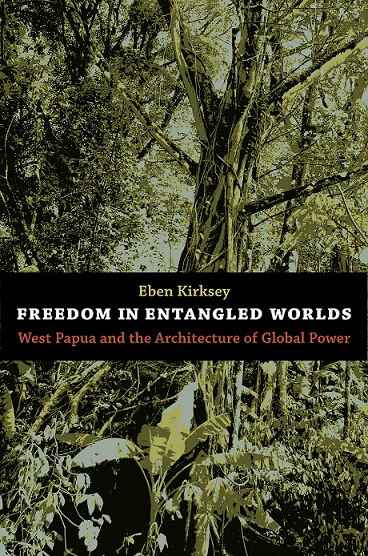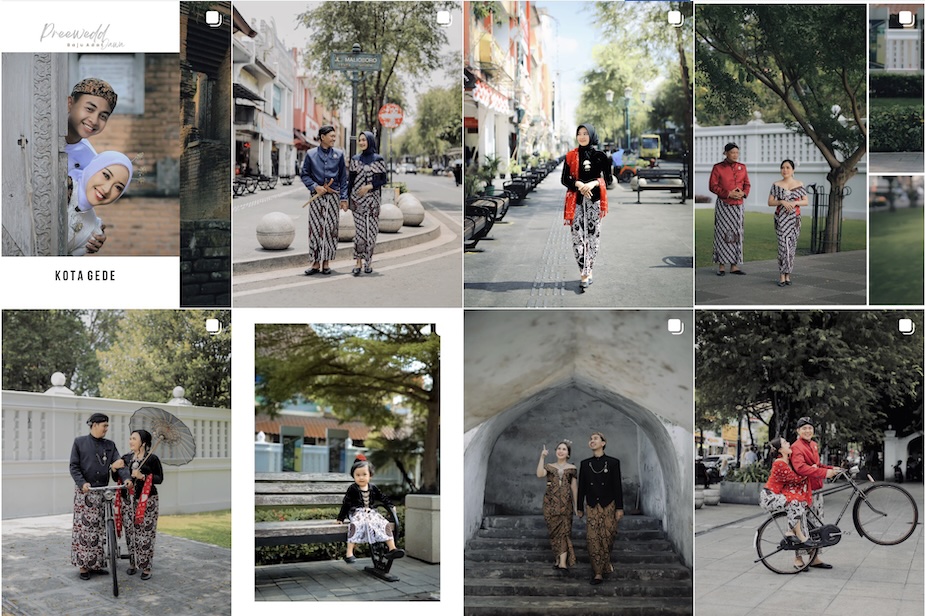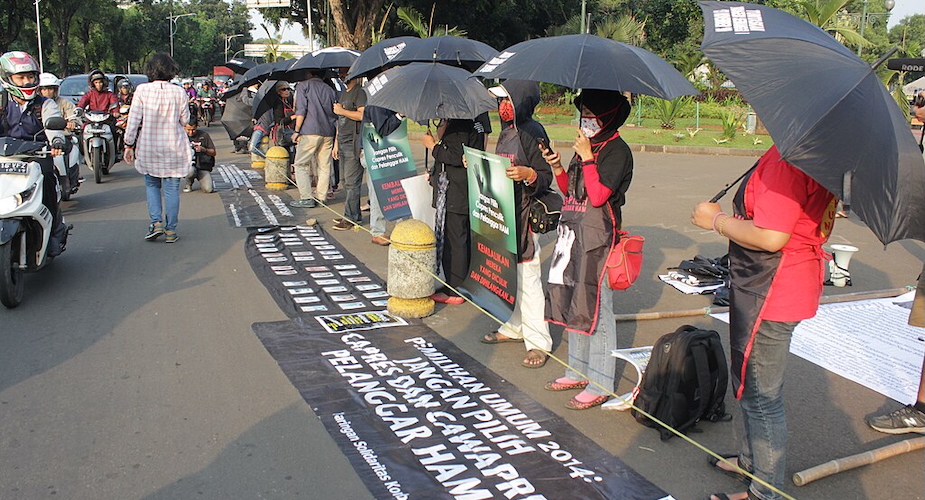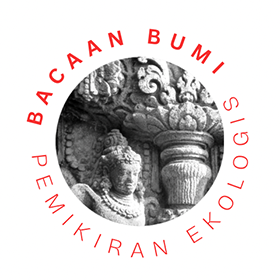Eben Kiksey invites the world to wake up to a crucial struggle unfolding in the Pacific
Jason MacLeod
Eben Kirksey was not always interested in freedom. When he first started his academic research in West Papua it was the effect of La Niña on farming amongst the Ekari/Mee people that captivated his attention. Kirksey was into insects, not independence. Like the metaphor of the Banyan tree absorbing its host, an image that Kirksey returns to again and again to describe the entangled relationships between resistance and power, Kirksey’s book depicts his own transformation from bystander to partisan.
I don’t use the word bystander lightly. Eben Kirksey arrived in West Papua for his first intensive research trip after the May 1998 revolution that deposed longstanding Indonesian dictator, Suharto. By riding a wave of economic instability and through large scale unrelenting unarmed pressure students fractured the political elite in Indonesia and ushered in democracy, an effort that has been stillborn in West Papua. Suharto’s departure released a pressure valve on years of suppressed longing for freedom in West Papua. It was in the wake of these events that Kirksey first came to West Papua. And as he describes in his book the only conversation people wanted to have was about freedom.
Shortly after arriving in the capital Kirksey witnessed the Indonesian government’s security forces open fire on unarmed civilians at Cendrawasih (Bird of Paradise) University in Abepura. Fleeing the violence he sought refuge on Biak Island. It was a case of out of the frying pan and into the fire. In Biak Kirksey was witness to a second shooting. Again the Indonesian military opened fire on a crowd of nonviolent Papuan protesters. Those not shot dead were rounded up, herded on trucks and taken out to a waiting warship anchored off the coast. Bodies later washed up on the shore. Many showed signs of torture. Over a hundred people were massacred that day and in the days that followed. Throughout the killing Eben Kirksey lay low, trying desperately to keep out of sight. Captain Andrew Plunket, an intelligence officer from the Australian Defence Force, later described the 1998 Biak Massacre as a ‘dress rehearsal for TNI (Indonesian military) violence in East Timor’.
But Freedom in Entangled Worlds: West Papua and the Architecture of Global Power is far more than a biographical sketch of one person’s journey from passive observer to active solidarity. With a depth of knowledge that few outsiders possess, Kirksey documents and analyses West Papuan resistance against Indonesian rule between 1998 and 2008. The result is an extraordinary book – part biography, part erudite analysis, part indigenous allegory, part history and part call to action.
Much scholarship and reportage on West Papua is dominated by two myths: a portrayal of West Papuans as some kind of noble savage and a preoccupation with armed struggle. Kirksey demolishes both with panache. He argues that expanding the contours of freedom in West Papua is about ‘negotiating complex interdependencies rather than promoting fictions about absolute independence’. The freedom desired by Papuans, Kirksey maintains, is both more than and less than independence. Kirksey is clear here, West Papuans desire independence from Indonesia but that desire extends to hopes to ‘actualise a new model of nationalism’.
Central to his argument are the concepts of collaboration and resistance. To illustrate the structures of resistance he employs the image of the Banyan tree – the strangler fig – and the rhizome, that subterranean decentralised network structure of entangled fibres and roots as organising metaphors. The Banyan tree represents the often misplaced faith that repressive power can be transformed without replicating structures of domination. The rhizome represents the fluid nature of collective action from below, power flowing subversively through unseen capillaries in the social body, a hidden potential to bring about large and decisive change.
Less useful – for me at least – is Kirksey’s use of the term collaboration. Not because Papuans are not seeking to cooperate with and exploit their entwined relationships with the Indonesian state; they clearly are. I found myself translating the word ‘collaboration’ because what Kirksey illustrates are several different types of entanglement each with their own unique dynamics. In West Papua overt resistance often operates side-by-side close engagement with power-holders. At times this is motivated by deep desires for political freedom. Then there is the tenacious ability to maintain dignity and self-identity in the midst of brutality such as the story of Ester, a Papuan woman subjected to sexual violence by the Indonesian military then taken as a ‘wife’. In the midst of this intolerable situation Ester finds ways to not only to survive but prevent acts of violence against her people. Kirksey also analyses the 2002 shootings in Freeport in forensic detail uncovering a complicated and compromising relationship between Papuans and the Indonesian military. But collaboration for Kirksey also means other things. He depicts the movements’ pursuit of intermediate strategic goals and ability to recruit powerful international allies. While at times these goals might be less than full freedom they also take the movement closer to the cherished goal of self-rule. As one senior indigenous West Papuan leader put it to me recently, “a demand for basic rights should not be the enemy of independence”.
Freedom in Entangled Worlds is not a dry academic book. Kirksey writes with verve. His analysis is sharp, his writing engaging. Kirksey draws the reader in. Not content to seduce the reader with tales of suffering – although he does that without recourse to sentimentality – Kirksey inspires solidarity. He probes and illustrates how Papuans are working to transform the conflict. He invites the reader to join her or his efforts with those of the Papuans. Although he documents the pervasive national and global architecture of unrelenting violent domination in West Papua, including a forensic examination of the role of the Indonesian military and FBI in the 2002 shootings in Freeport, this is not a depressing book. It is infused with a subtle sense of hope. Kirksey amplifies the voices and imagination of Papuans who see not only a repressive global net that binds and restricts action, but who imagine that ordinary people can ‘join with … friends to encircle and penetrate existing architectures of power – town councils, corporate boardrooms, national parliamentary assemblies – like a multitude of Banyan tree saplings slowly growing up and around the canopy trees of a forest’. Whether talking about the Indonesian military or transnational corporations like Freeport and BP, Kirksey shows how the worlds of domination and resistance are entangled.
Ultimately Freedom in Entangled Worlds pries open the shutters that have ensured the international communities gaze remains averted from the brutality and injustice that is unfolding in West Papua. Kirksey exposes the violence of the Indonesian military, the greed of transnational corporations and the wilful neglect of the international community. But in doing so Eben Kirksey achieves something far more important. He illustrates that in the spaces in between entanglement and domination Papuans are enacting surprising indigenous visions of peace and justice and with them possibilities for change.
The struggle in West Papua is as extraordinary as it is complex. But Kirksey is a gifted narrator and patient guide. Combining metaphor, mysticism and allegory with the hard positivist data of the most rigorous investigator, Kirksey delivers a brilliant read wrapped up with enormous insight. He does the struggle for freedom in West Papua a great service.
Eben Kirksey, Freedom in Entangled Worlds: West Papua and the Architecture of Global Power, Durham, NC: Duke University Press, 2012.
Jason MacLeod (damai@bigpond.com) works as an educator, researcher and community organiser. He recently completed his doctorate on Civil Resistance in West Papua at the University of Queensland.












